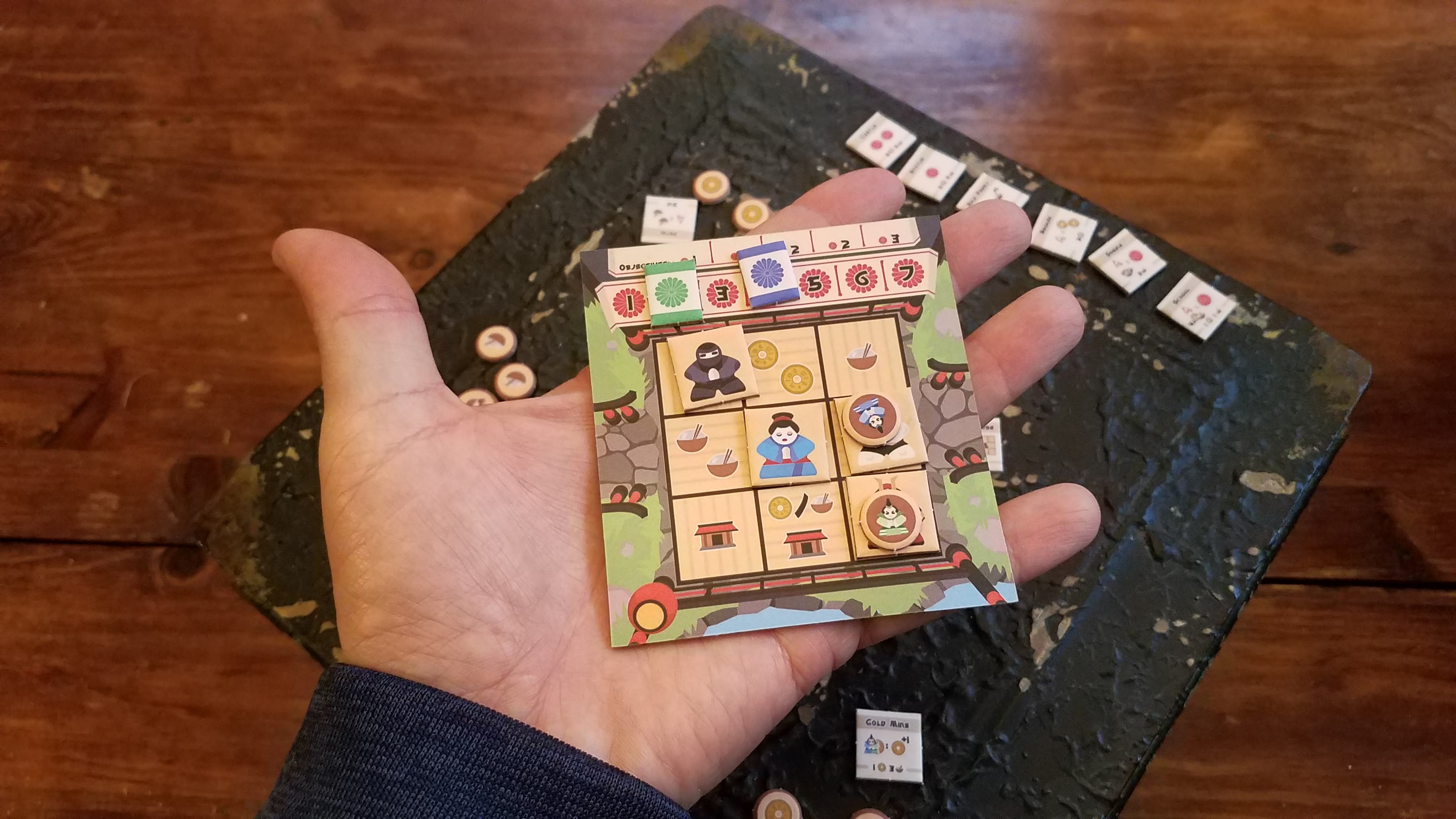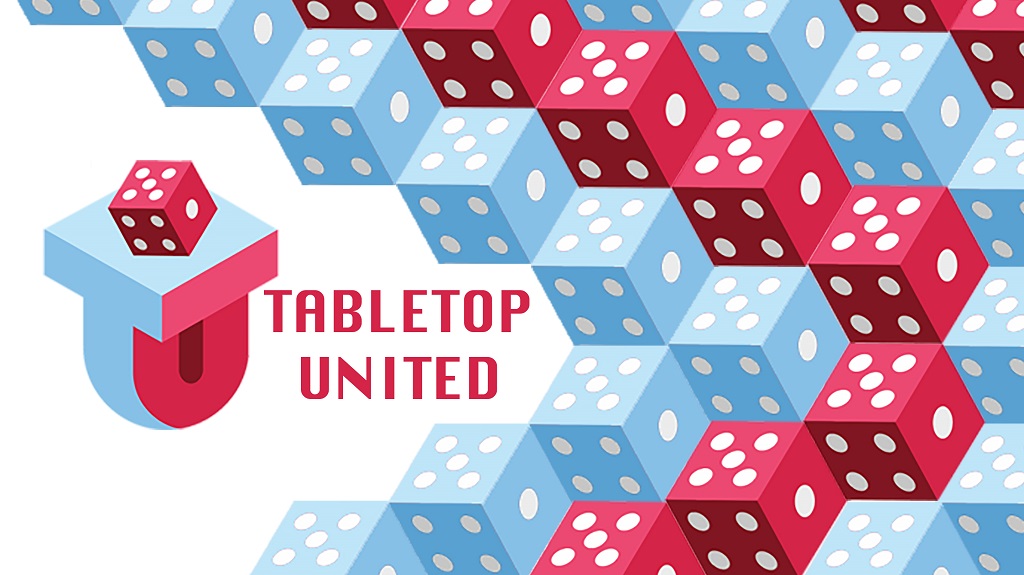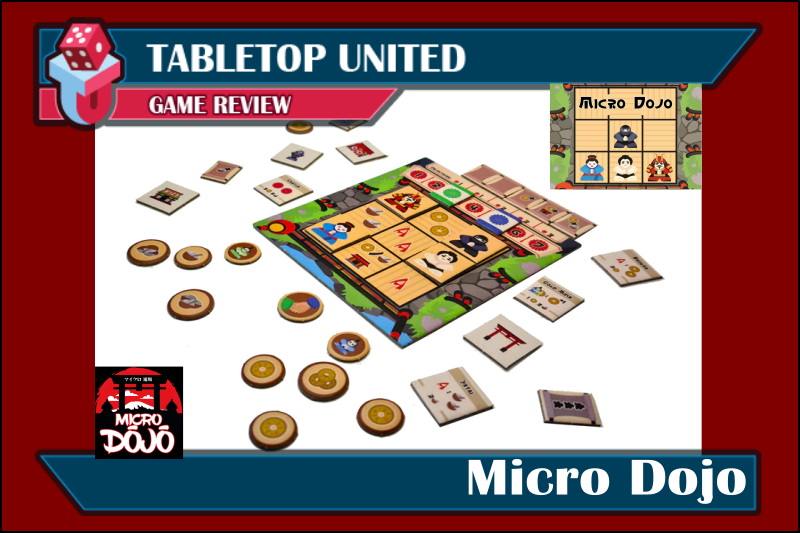Karate in a Micro Dojo
Designer: Ben Downton
Artist: NA
Publisher: Prometheus Game Labs
Kickstarter Duration: 2021/05/09 - 2021/06/01 (22 days)
No. of Players: 2
Ages: 10+
Playing Time: 10-30 minutes
Main mechanic / Theme: Strategy, Area movement, Edo Japan
Collect rice, gold, and build buildings in the tiniest of dojos in Edo era Japan
Find more info on BoardGameGeek & Kickstarter
Disclaimer: The publisher provided a preview copy of the game for this review.
Overview:
Micro Dojo is exactly what it says it is. A small (micro to be exact) game set within the confines of a small dojo. Players will push a chosen tile across the floor of the dojo claiming actions. Those actions range from taking gold, food, building buildings or taking additional actions to trigger objectives, activate a building’s ability, trade your resources, or donate gold or food for victory points. The cuteness of the game makes for an enjoyable, and tactical, “micro-game.”
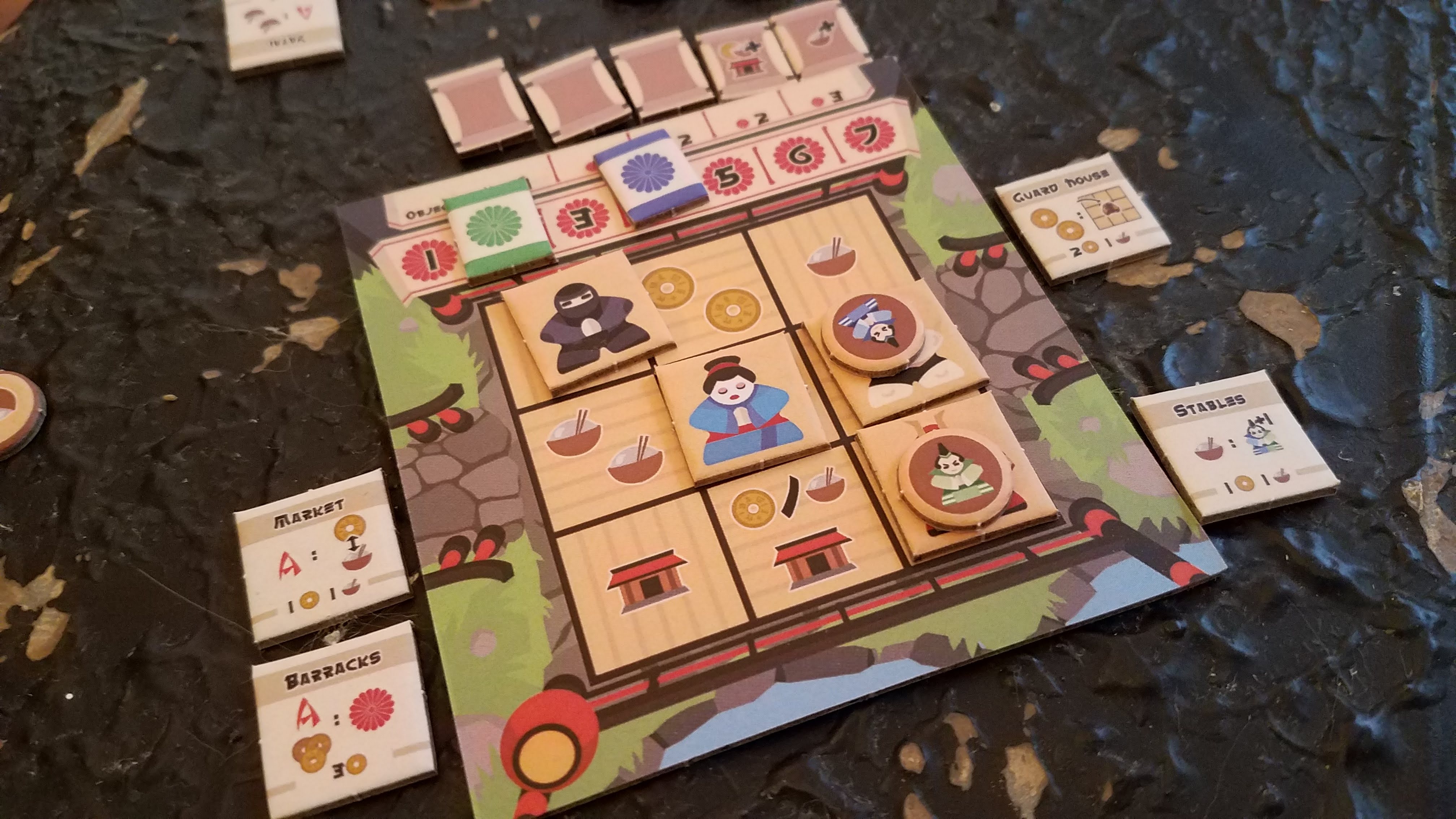
Gameplay and mechanics:
Micro Dojo is an area movement and resource collection game where you use those resources to build buildings and claim objectives to earn victory points. On a player’s alternating turn, she will move an available meeple tile to claim a space in the dojo to gain the resource or action. After moving a meeple tile, you’ll place your player marker on that tile to show that the tile is not usable again until you move another meeple tile next turn. Next, the active player resolves the specific space to gain gold or food or pay the cost to build a building. Otherwise, the player may remove an owned building from the game for points or use the wild symbol to take an action of your choice. The wild actions available are to trigger an objective at the top of the game board, activate a building’s abilty that you own, trade resources for other resources, or donate gold or food for one victory point. All of these are marked on the dojo on the gameboard so it’s easy to see what your options are.
So, you move a tile with a meeple on it which then claims a space on the dojo giving you actions and options. That meeple tile can’t be activated again until the end of your next move. Picking the right tile and denying your opponent access to spaces and other tiles is the strategic part of the game. There are only 9 spaces and four meeple tiles, so at any one time after the first turn of the game, you only have two tiles to choose from to move to a new space. You’ll end up being blocked at some point so you have to choose your next best option and make the best of it. In such a small space, two players is enough and you’ll be kicking, punching, and blocking your way across the dojo to claim the best space for your upcoming objectives.
Speaking of objectives, five are placed along the top of the board and each one garners you more points- the first two are worth 1 point each, the 3rd and 4th are worth two points each, and the last one is worth 3 points when its achieved. The player with the most victory points is the winner. The game ends when someone reaches 7 victory points or the last objective is scored.
As a strategy game, understanding the gameplay comes fairly quick- move a meeple tile, gain a resource or take an action, then it’s your opponent’s turn to do the same. However, pushing the meeple tiles around to block your opponent or grab the most lucrative open space is the part that makes Micro Dojo exciting for me. I played several games with my 15 year-old daughter who’s been playing games with me during the pandemic, and she picked up on the game in her second turn. It was a swift jab to the stomach that I failed to block which led her to her first victory in Micro Dojo.
There are a total of 12 buildings and 9 objectives in the game. This variety should give a nice bit of replayability in a small package.
Furthermore, some advanced rules in the game allow for different challenges with an additional 5 advanced objectives and some advanced movement options with the meeple tiles.
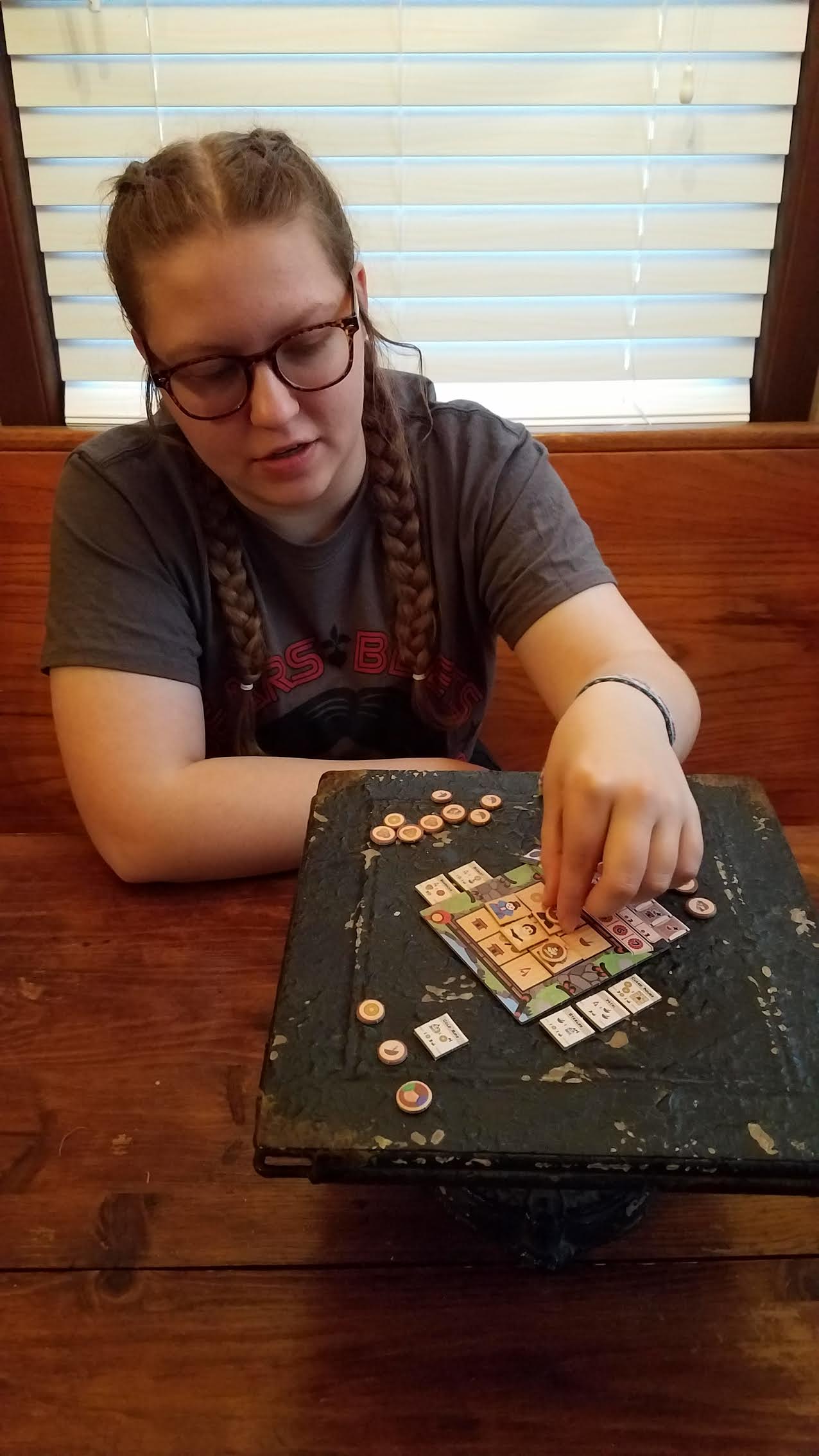
Theme, Artwork and Illustration, Graphic Design and Layout:
The theme is well done in regard to conveying a sense of culture with the game. Since Micro Dojo is set in the Edo period of Japan, the images and iconography fit that period. Layout is done well, and, even with the game being “micro” sized, you can still tell what each objective is as well as each location on the dojo floor when you do a cursory glance. I have to use reading glasses when reading card text and the tiny size did NOT bother me at all. The items are small, but the text isn’t any smaller than what you find in other larger, “normal” sized games.
I know nothing about this time period in Japanese culture. However, I immediately questioned how playing in a dojo gained me food, rice, and the chance to build buildings. When I think of a dojo, I think of physical activity with two components competing in a physical challenge. Not to be the one who has the most rice, most gold, etc, in order to be the victor.
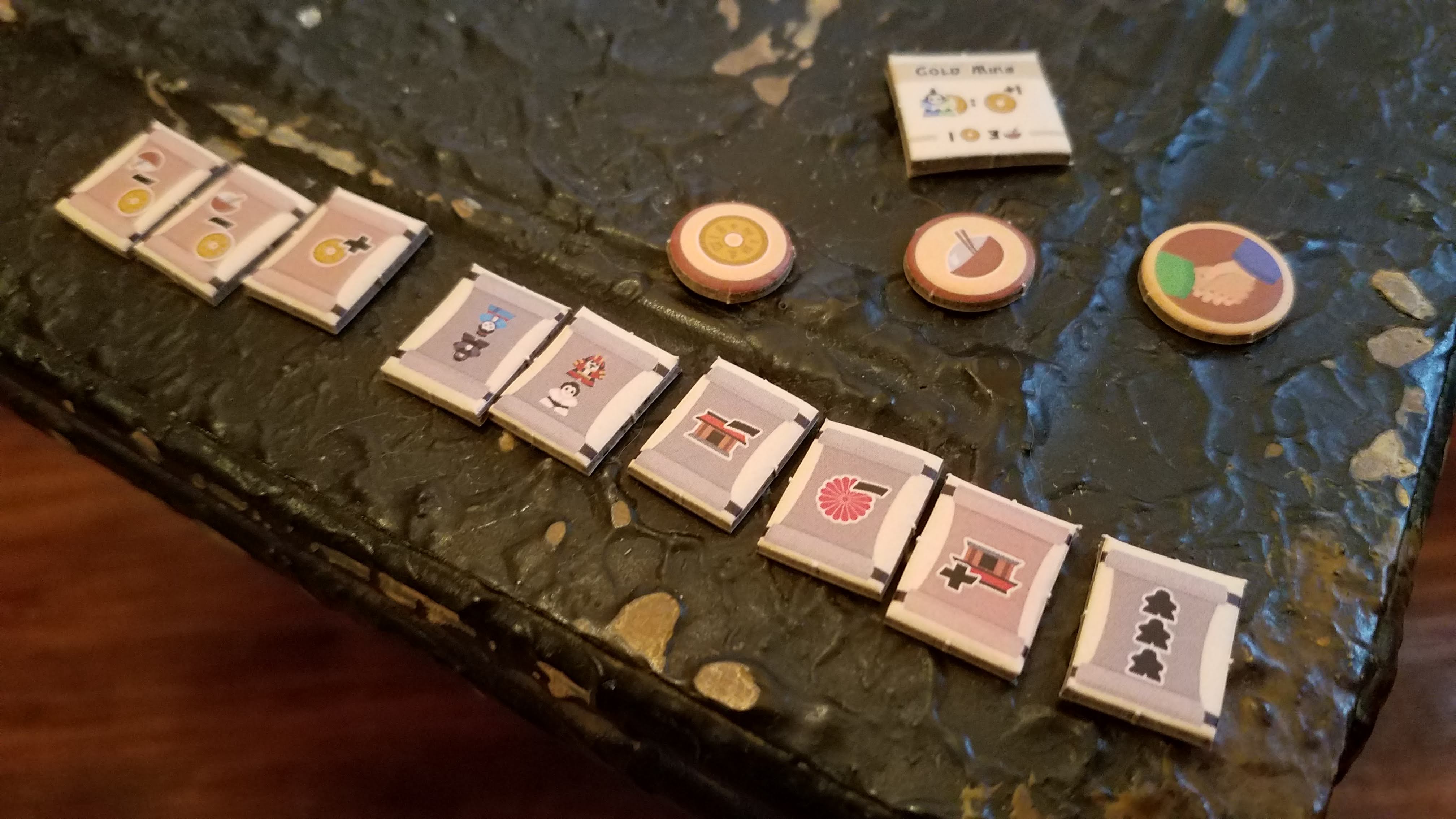
Inclusivity and Accessibility:
Tabletop United believes that diversity is a source of fun and happiness. Nurturing and celebrating our personal differences can lead to amazing gaming (and life) experiences. Therefore, TTU is putting renewed emphasis on inclusivity and accessibility by adding a section in each of our reviews written after April 2021. You’ll begin to see more reviews with this section as time goes on. The inclusivity and accessibility section will critique those issues and strengths of the subject in the review based upon the unique background of the reviewer. Each reviewer views the world through their own particular lens and has a wide and varied experience from which they will write and review from.
My understanding is that Ben Downton included many consultants when designing the game. The Kickstarter page discusses this in a bit of detail. I am not of Japanese descent or origin so I can’t discuss whether people with Japanese heritage would feel upset over this project. However, personally, I like the fact that, although this is a game, it does introduce me to the Edo time period in history.
Being color-blind, I didn’t find any issues with colors, and identifying the various figures and icons was not problematic either. The publisher did a great job in this area- at least to my eyes!
The game is pretty small. An adult’s hand is about the size of the board for Micro Dojo. I mean, it’s in the name, so if we’re going to bash it for being small, why would we pick this game up just to complain about the size of it? That’s sort of the point, though, right? To have a small footprint that doesn’t take up much space and is easily stored. Just be careful not to bump things as you move your meeple tiles around, though. The micro-form factor doesn’t bother me in the slightest. If the small size is going to be an issue for you, it would be best to avoid this game. You can back the game for a print and play version so I would suspect you could enlarge the components when you print them. Check out Micro Dojo. You'll be surprised by the "micro" price!
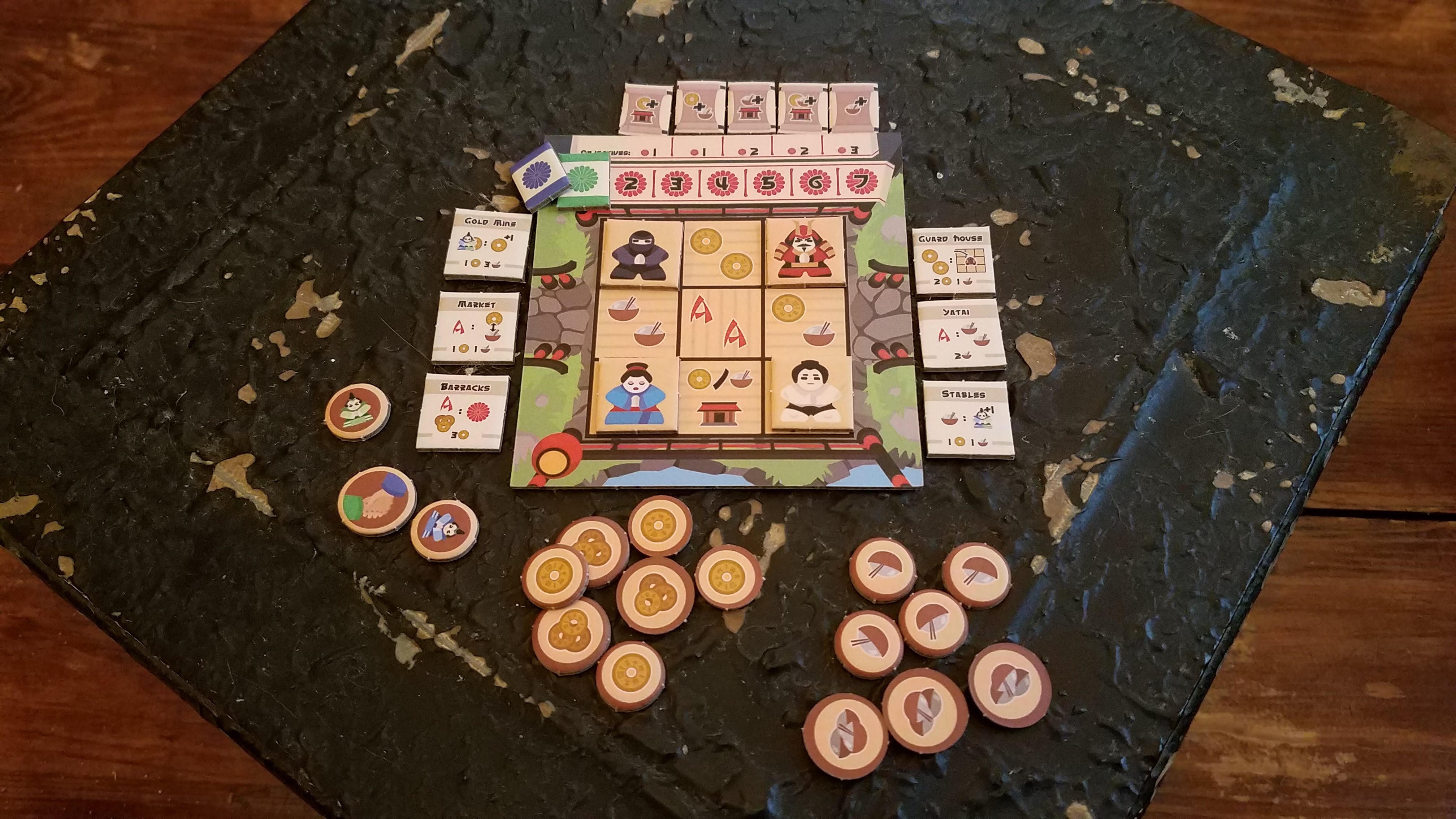
What worked:
I normally don’t like to make comparisons, but this game does what it does well. If Scott Almes can do a series of “tiny epic games” then Mr. Ben Downton can do “micro” games also. The strategy of moving onto specific squares and blocking your opponent is an interesting decision and the mechanics seem to flow. There aren’t too many resources, there aren’t too many spaces, there aren’t too many buildings, etc, etc. It feels just right for what it is. A micro game. Adding in one or two more spaces, objectives, buildings, etc, would probably ruin the game for me. It’s good at being a two-player game and I suspect it just wouldn’t work with additional players. People who enjoy faster strategy games in a small two-player package should pick this up and enjoy it.
Final thoughts:
Considering this game, I think Ben did a great job with his idea. It is small so it ships well. Managing production shouldn’t be too difficult either with just a single die-cut sheet and shipping it shouldn’t cost hundreds of dollars. Ben created a great game in a small package- You and an opponent duking it out in a dojo to gain resources, build stuff, and claim objectives. The game probably won’t make it onto retailer store shelves as it will get lost within it’s larger boxed cousins. If you can afford a few dollars, back Micro Dojo or order directly from the publisher after delivery of the Kickstarter is over.
